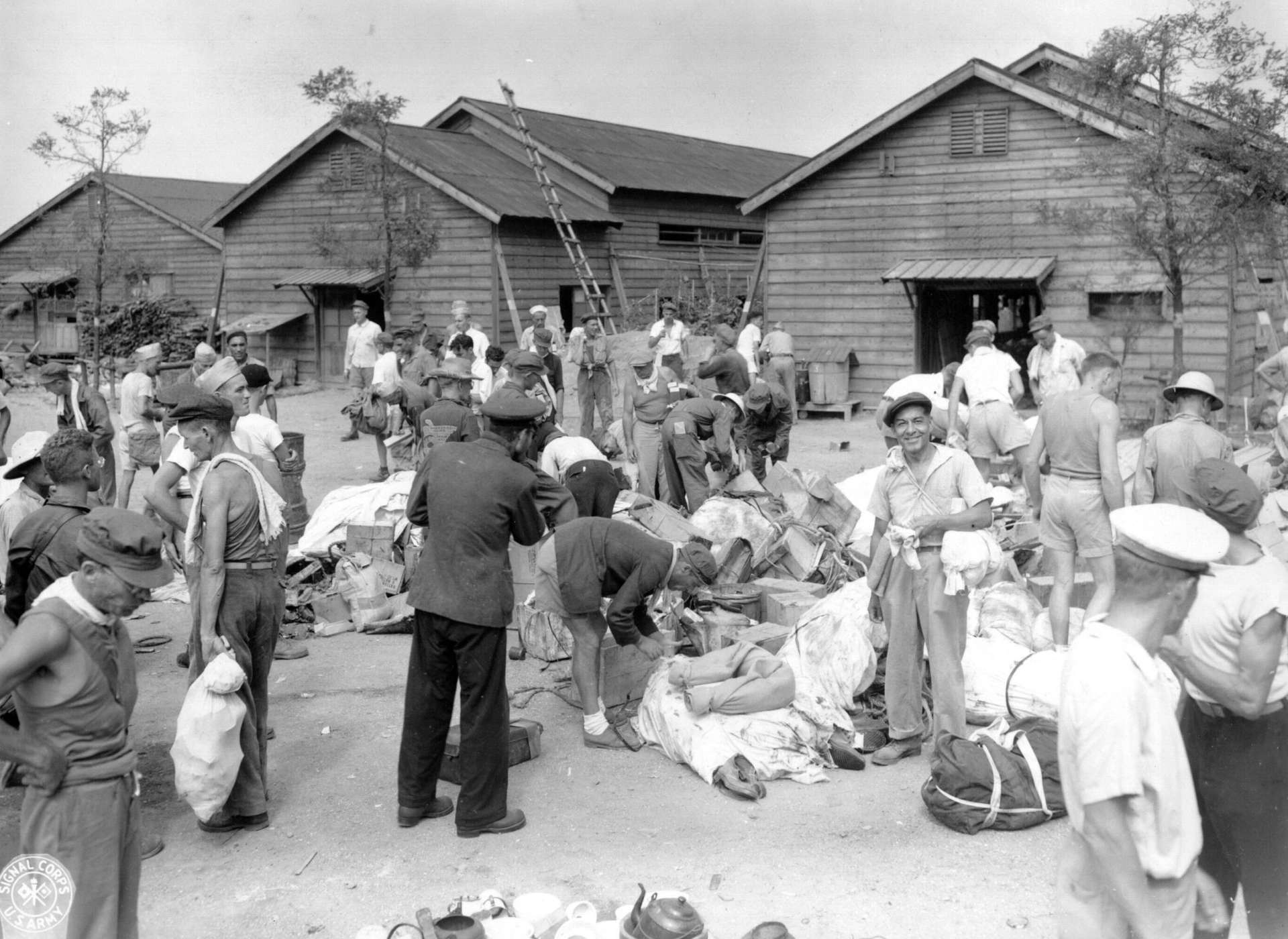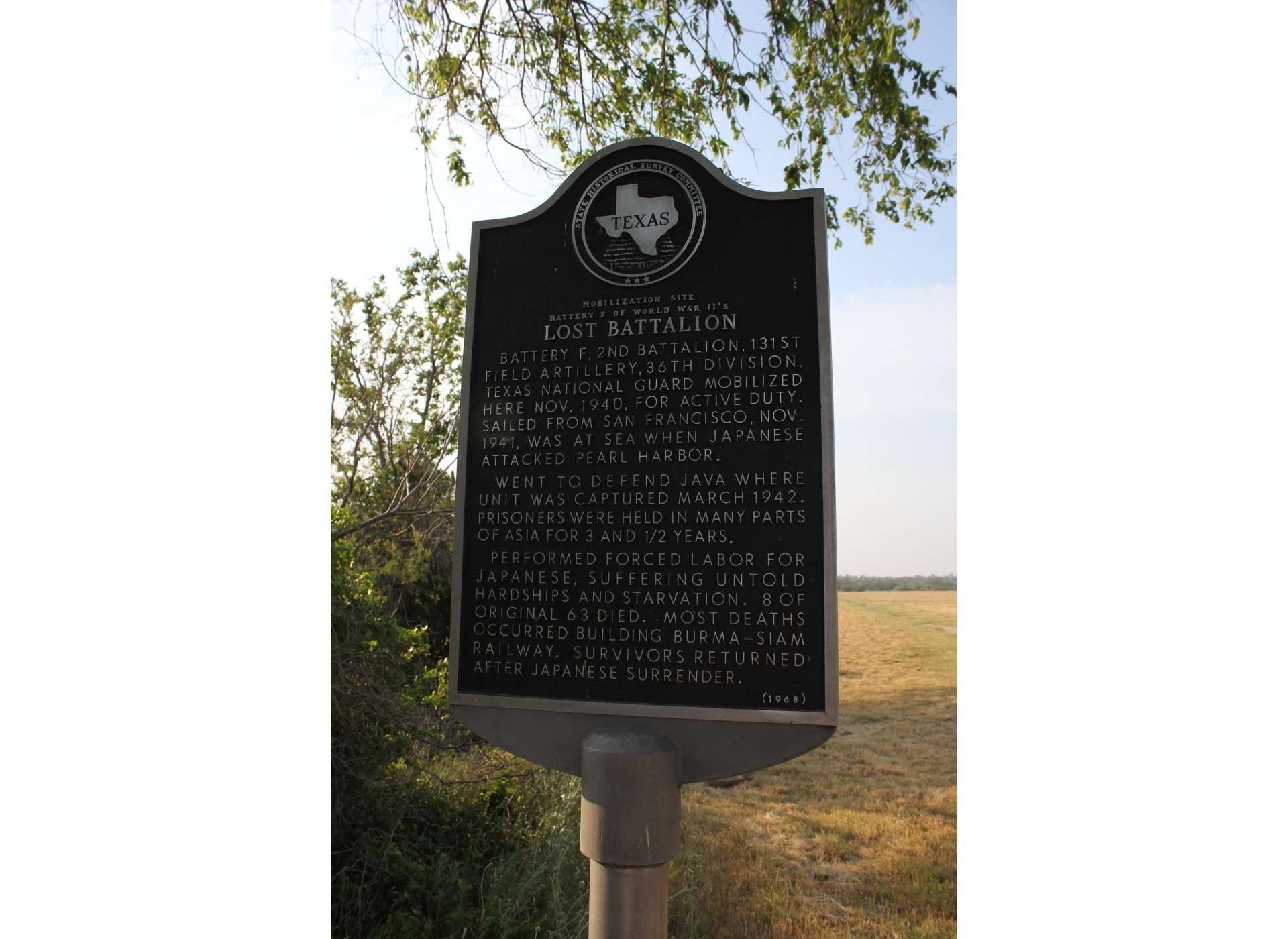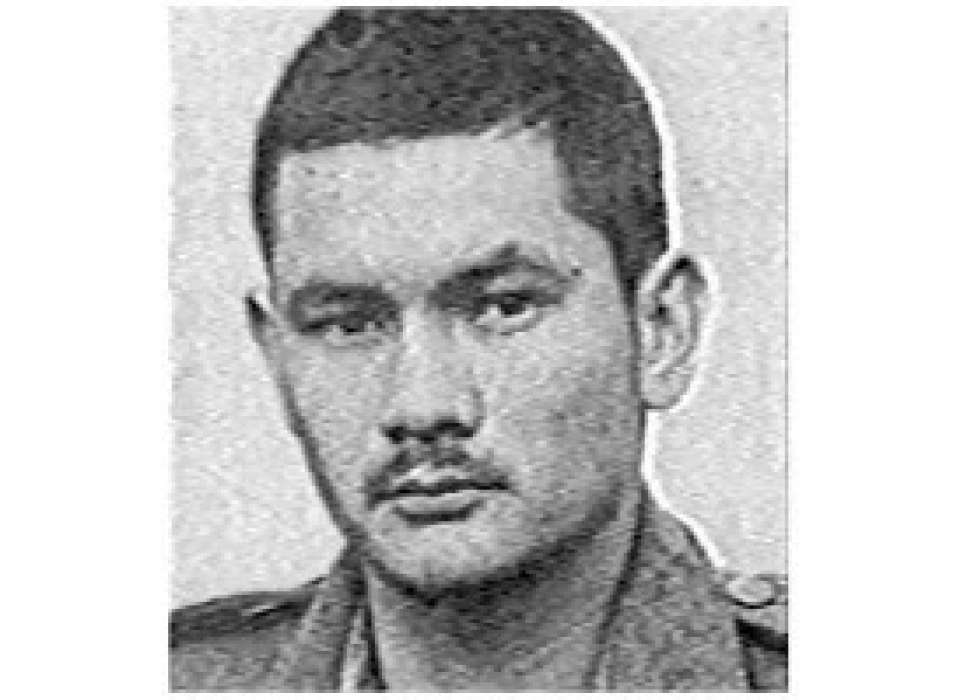Top image: Photo of Frank Fujita while at the Fukuoka # 2 Japanese POW camp, 1942, courtesy of the US Army.
On September 4, 1945, 550 prisoners of war (POWs) liberated by the United States Army from the Japanese Omori Prison Island Camp in Tokyo Bay crowded Atsugi Airfield in Kanagawa, Japan. Only one of the prisoners grabbed the attention of reporters from Time and Life magazines, who clamored to get his story amongst the other malnourished survivors of brutal torture and violence.
Sergeant Frank “Foo” Fujita–a man who made it through three and a half years of imprisonment first in Java and later in Nagasaki and Omori–had a story worth telling beyond his first-hand experience with terror: he was a Nisei, or second-generation Japanese American who served in the Pacific. For reporters, the idea of a man of Japanese descent being held prisoner by and fighting against Japanese forces was simply too fascinating to pass up. As one of only two Nisei held as POWs by the Japanese in the Pacific Theater of the war, Fujita’s story of extreme human suffering and survival is made more remarkable by the fact that he kept a secret diary during his imprisonment. Not only does it afford readers first-hand accounts of his captivity, the diary also details Fujita’s grappling with his own racial and ethnic identities.
Fujita’s journey through the jungles and prisons of the Pacific began in Oklahoma. His father, Tsuneji Fujita, migrated from Japan to the United States in 1914. Smitten with America and its opportunities, Tsuneji changed his name to “Frank” and repeatedly tried to naturalize at a time when American laws barred Asians from becoming citizens. Dismayed but not discouraged, Frank found work as a cook with the Rock Island Line (a rail road based in Illinois) and traveled across the country. During a layover in Illinois, Frank fell in love with a young white waitress named Ida Pearl. The couple married in 1919, and, in 1921, Ida Pearl gave birth to their second son, Frank Jr. The Fujita family spent the next decade following Frank Sr.’s job prospects before settling in Abilene, Texas in 1937, when Frank, Jr. was 16.
Texas’s Japanese American population was small in the 1930s, but Frank Jr. never struggled for friends. He always had a number of white companions, and his father made it a priority to live in towns that had few or no Japanese American families so that his children would be “100 percent American.” Fujita used his easy-going personality and wit to win over his classmates and his artistic skills to impress his teachers with his sketches and stories, including one of a cartoon cat named “Foo.” Frank Jr. illustrated funny stories of Foo’s adventures so often that his friends christened him with the cat’s name, which Frank Jr. answered to ever since. He eventually became a staff cartoonist for his high school’s newspaper, earning him more friends including one of his best, Roy McCullough, who loved Foo’s cartoons.
Besides encouraging Foo’s artistic development, McCullough’s enlistment in the Texas National Guard also had a profound effect on where Foo’s life would take him. Wowed by Roy’s stories of “adventure, excitement, and good times in the guard,” seventeen-year-old Foo rushed down to the local recruiting office to sign up. Being underage, Foo’s father gladly granted him permission to join the National Guard because “he wanted his children to be one hundred percent American, and what better way to be in the service of [his] country?” But the recruiting officer wasn’t initially convinced: He told Foo that he had to be an American citizen to enlist. “It seemed that there was a question as to whether I was [a citizen] or not and so the question was turned over to the civics teacher at the high school,” Foo recounted. “Well, there were a lot of pros and cons and a lot more of ignorance, but it was finally decided that I was indeed a natural-born citizen.”
With the question of Foo’s citizenship answered, he enlisted in Headquarters and Headquarters Battery and Combat Training, 1st Battalion, 131st Regiment, 61st Field Artillery Brigade of the 36th Infantry Division of the Texas National Guard, where he was assigned as a Private First Class chauffeur. It was not the most exciting of duties, but Foo also moved in with his friend Roy McCullough in Abilene in 1940. There he worked in a cake shop and “hung around the armory, gobbling up all the rumors of possible mobilization” following Hitler’s invasion of Poland the year prior and rising tensions in the Pacific. Foo was sure that the 36th Infantry Division “stood a good chance of being one of the divisions called up” if the National Guards were mobilized.
Foo would soon experience more excitement in his duties later that year. In August, he took a leave of absence from his job at the cake shop so that he could participate in the first Louisiana maneuvers along with other members of his artillery battalion. The maneuvers encompassed more than 400,000 troops in mock battles in northern and central Louisiana in 1940 and 1941 to train men for a potential war. When the maneuvers were complete by the fall of 1941, Foo received news that the field artillery battalion with the highest score from the mock battles would be assigned overseas to a place simply called ‘Plum.’” When Foo discovered that the 2nd battalion of his 131st Field Artillery regiment would be the one to ship out, he immediately sought a transfer from 1st Battalion Headquarters to 2nd Battalion Headquarters, because “no one was going anywhere” without him. When he learned that all of the sergeant positions in the 2nd Battalion were filled, he jumped at the first chance to become a Machine Gun Sergeant in E Battery. On November 10, 1941, Foo and his battalion loaded their equipment onto separate trains and left for Fort Mason, California. Following their arrival, they set sail across the Pacific aboard the United States Army Transport Republic, bound for “Plum”--which Foo and the others had figured out was more than likely the Philippines–after a stop in Honolulu for supplies.
After some free time and resupplying, the Republic left Hawaii on November 29, unaware of the different route their trip would soon take. When not undergoing training in using the ship’s anti-aircraft guns, Foo spent his time sneaking 190-proof medical alcohol, playing poker and craps, pranking other soldiers, and, of course, drawing. “As the days passed and we became accustomed to the battle drills, there were still those who were convinced that this trip was some sort of glorified sight-seeing trip,” Foo wrote. “But on December 7, 1941, this illusion was shattered forever when the loud speakers began blaring out that Japan had just bombed Pearl Harbor and pandemonium broke out aboard the ship.”
“It was almost unbelievable that such a thing could happen and that Japan would dare to attack the mighty and invincible United States. The shock was compounded by the knowledge that we had just left there a mere eight days before, and here we were out in the middle of the ocean, not too far away, and most of our fleet had been sunk in the raid at Pearl!”
Following Pearl Harbor, Foo also became acutely aware of his ethnicity. During the daily information programs a few days later, the announcer asked if “there was a Jap on board this ship?” Foo decided to write a reply for the announcer to read during the next daily program: “I do not know if there is a Jap on board or not, but there is an American army sergeant who happens to be half Japanese–I know, for I am that person, Sgt. Frank Fujita.” Foo never encountered any more questions like this on the ship, but he remained “apprehensive for a while.”
Foo’s service on the ship also reflects his unique status as Nisei serving in the Pacific. Because his family lived in Texas, the government did not require them to relocate or spend time in one of the incarceration camps for Japanese Americans established after President Franklin D. Roosevelt signed Executive Order 9066 on February 19, 1942, since they lived beyond the military zones of the West Coast. Also, as historian Jeffrey T. Yamashita explains, despite the War Department excluding Nisei from service following the attack on Pearl Harbor, Foo was able to see combat in the Pacific due to lax and decentralized policies of local recruiters who sometimes ignored or overlooked the service of Japanese Americans. Although Japanese Americans served in the Pacific as interpreters and other noncombatant roles, Foo was one of only two Nisei who were taken prisoner by the Japanese (the other was Richard Sakakida, a member of the Counter Intelligence Corps stationed in the Philippines).
In response to the Japanese attack, the Republic shifted course and set off for Brisbane after resupplying at Suva, the capital of the Fiji Islands. Once docked at Brisbane, the men aboard were granted leave to go and explore the city before Foo’s battalion boarded the Dutch liner Bloemfontein, a fast-moving vessel that could transport artillery units to the Philippines as quickly as possible. But while the Bloemfontein was moving through the Timor Sea as part of a convoy, a Japanese submarine sank a Norwegian tanker and the SS Liberty. The Bloemfontein docked at the port of Soerabaja in Java, part of the Dutch East Indies. The following day, Foo and his men made their way to Singosari–an army camp with an airfield used by what was left of the Army’s 19th Bomb Squadron’s B-17 planes after a Japanese attack.
From January to March of 1942, Foo was stationed at Singosari as forces regrouped and he filled his diary with encounters with British, Dutch, and Australian soldiers and officers in local bars (being from Texas, Foo noted he was able to drink the British soldiers under the table) and the wildlife that managed to make its way into Foo’s tent. He also recounted his first experience on February 3, 1942 with a bombing raid by the Japanese.
“This was our first raid and we were fascinated by the ghostly formation of planes. Their white undersides made them hard to see distinctly, and they looked like ghosts. We watched as they opened their bomb bays and saw the bombs leave the planes in long strings. It all seemed fairylike and unreal. The whole scene did not seem threatening. War and bombing raids were something that we had read about that happened to other people in other times and places and had nothing to do with us.”
But the threat of the Japanese soon became all too real for Foo. On February 28, the Japanese army invaded Java at Merak, Bantam Bay, Eretenwetan, and Kragan. Under the command of British Major General H.D.W. Sitwell, Foo fought alongside Dutch and Javanese soldiers during the Battle of Soerbaja on March 7.
Foo was enjoying a cold beer when a sergeant came back and reported that there were some American soldiers who had just arrived. Foo had heard rumors about American reinforcements and eagerly jumped up to go greet them, only to discover that they were Japanese troops. Foo grabbed a rifle and fired at the group. “My heart was pounding so hard I thought it would burst,” he wrote. “I was hyperventilating, and I fired off two more wild shots without hitting anything…I thought to myself if I didn’t pull myself together, I would be a goner.” Foo took a second shot and killed a soldier, prompting a Dutch officer to ask him what he would do if he “looked down [his] rifle and saw one of [his]” indicating another Japanese soldier. Foo replied, “He had better shoot before I did.”
Despite the fighting, on March 8, the Dutch surrendered the East Indies to the Japanese, followed by the British, Dutch, and American forces on March 12. For the next seven months, Foo, his battalion, members of the British and Dutch forces, and other Americans aboard the USS Houston, who were taken prisoner by the Japanese after it sank during the Battle of the Java Sea, were held in a prisoner camp in Jaarmarkt at a fairground. Though Japan agreed to respect the terms of the Geneva Convention of 1929, Foo’s secret diary proved otherwise.
Once herded into barracks, some of Foo’s fellow soldiers urged him to change his last name to “a Spanish or Filipino name” because they were worried that he would be shot once the Japanese guards discovered that he was of Japanese descent. “I was really in anguish,” Foo wrote, “for I thought the same thing, and the temptation to change my name was almost overwhelming.” But he ultimately decided against it. “I felt that if I changed my name and I should die for any reason during the war then, if my death were reported at all, it would be reported under my assumed name and my parents would never know what happened to me.” He also noted that the decision was not an easy one, since he felt his “longevity would certainly be brief, under the circumstances, with a name like Fujita.” Foo also encountered suspicion among the Dutch POWs who, once finding out that he was half-Japanese, became convinced that he was a Japanese “plant” to spy on them. Foo was able to win them over, but his ethnicity would continue to put him in danger at the hands of Japanese guards.
Foo was able to record his subsequent experiences in the prisoner camps thanks to members of the Salvation Army. On April 29, the guards at Jaarmarkt allowed a rare visitors’ day for prisoners in honor of the Emperor’s birthday; typically, local Dutch women attempted to deliver supplies through the prison gates but were severely beaten by guards. Most of the prisoners requested uniforms to replace their tattered rags, but Foo also asked for some art supplies. The Japanese forbade the uniforms but, interestingly, allowed Foo to keep the drawing paper, pen, and ink.
In October of 1942, Foo and other prisoners were shipped off to Singapore and detained in the Changi military base there. The Japanese employed captured British soldiers as guards, which rancored Foo and the others, viewing them as sell-outs and traitors who gleefully served the men maggot-infested rice–when they served them food at all. Foo developed a severe case of dysentery as did others at Changi and, while he was allowed a hospital stay, he was discharged and forced back into the same deplorable conditions that caused his illness. Food rations were severely cut and the men, suffering from starvation, sought out any extra morsels to abate their hunger including jungle snails and whatever seeds they could scavenge to roast.
In late November, Foo and another thousand prisoners were boarded onto a ship bound for another Japanese prison, Fukuoka POW Camp #2, located on an island off the coast of Nagasaki. Once there, the Japanese split the prisoners up into work crews. Foo was part of the group put to work in the dockyards constructing ships. “The work at the dockyards was so hard, the weather so cold, and the food rations so inadequate, it was surprising we were able to withstand the demands made upon us,” Foo penned in his diary. “We would return to camp in the evening bone weary and barely able to walk. The effects were accumulative, and as time went on we became weaker and even more susceptible to the ravages of disease and malnutrition.”
Foo went on to describe the impact of the horrors on the men. “All through the night, men would scream out from the effects of dry beriberi. Every cell of our bodies was crying out for rest, but this was not to be had.” And every night before bed, the prisoners performed “the gray-back ritual,” where everyone removed all of their clothing “and meticulously search[ed] every seam and wrinkle and remove[d] the big gray-back lice” that nested in their clothing. Necessary trips to the latrine outside of the allotted time for relief resulted in beatings from the guards, made all the worse for the men who suffered from dysentery and diarrhea.
The true terror for Foo, however, came in June of 1943 when a guard at Fukuoka eventually realized that Foo was of Japanese descent. When the guard was reading the work crew roster and came across the name “Fujita,” he immediately began looking the prisoners over to try and find a Japanese man. Foo was terrified of a guard exacting revenge on a prisoner who was half-Japanese and believed to be a traitor to Japan. Fortunately for Foo, the guard was more interested in taking him to the camp commander to be questioned on why he was fighting with the American army.
“Fujita is a Japanese name, is it not?” the commander asked.
“It is,” Foo replied.
“Then you are Japanese?”
“I am an American citizen.”
“Your name and blood are Japanese.”
“I have other blood than Japanese and I am a native-born American.”
Foo continued with pro-American responses to the line of questioning, only further angering the commander who, as punishment, insisted that Foo learn to read and speak Japanese. Foo was assigned to a corporal for his lessons who became increasingly frustrated that his student failed in his studies. One day, the corporal grabbed his sword and “made a violent pass” at Foo’s neck. Foo managed to jump out of the way in time to avoid being cut, but the incident left him shaken. For reasons unknown, the commander released Foo from his Japanese lessons and allowed him to return to his former duties in the dockyard following a failed attempt to use Foo’s English capabilities and Japanese heritage in an anti-American radio propaganda campaign.
But once other guards were aware of Foo’s ethnic background, they took every opportunity they could to attack him. On August 6, Foo was not working fast enough moving large, staging planks for ship construction, prompting two guards to discipline him for his poor behavior. They proceeded to pummel his face, kick his chest, and repeatedly hit his spine with a large bat. “I did not know that pain could attain such a high degree of intensity,” he wrote in his diary. “My entire head seemed to explode, my senses spun around and seemed to pulsate in and out, bordering on unconsciousness…I thought that I could not possibly take another blow. I kept telling myself, ‘do not make a sound; whatever happens, do not fall to the ground, do not let [them] know that they have broken your spirit.’”
Foo continued to experience the harsh realities of life as a prisoner of the Japanese, moving from Fukuoka to Omori Prison Island near Tokyo in October of 1943, where he spent his last two years of confinement. Foo and the other members of his battalion (most from Texas) became known as the “Lost Battalion” as their location and status were unknown from 1942 to 1943. Finally in February of 1943, a transcription of a Tokyo shortwave radio broadcast revealed that Foo was alive and being held as a prisoner of the Japanese.

POWS at the Omori Prison receiving new clothes, undated, courtesy of the National Archives and Records Administration.
Freedom for Foo and 550 other prisoners at Omori came at last with the liberation of the camp on August 29, 1945, following the earlier atomic attacks on Hiroshima and Nagasaki. Foo and the others were transported to Yokohama on the USS Monitor before ending up at Atsugi Airfield. While reporters clamored about the rescued men, Foo was focused on getting home. In October, after “an eternity of sailing,” Foo re-entered the United States through Tacoma, Washington.
For the next few years, he bounced around at different jobs, struggling with “ a number of disillusionments with civilian life” and dealing with debilitating back pain from his injuries at Fukuoka. In 1948, he decided that if he were “going to fall apart, [he] might as well do it in the army,” and reenlisted in the reserves. But later that year as he was boarding a ship for the Pacific, he was handed a subpoena from the Federal Court in San Francisco to appear as a witness on behalf of Iva Toguri D’Aquino, or “Tokyo Rose,” based on Japanese attempts to use him for radio propaganda while he was a POW.
Foo was called to active duty a final time during the Korean War (though he did not serve overseas), but then returned to his love of art and became an illustrator for the Air Force, eventually marrying for a second time and traveling around the country with his wife.
And what happened to Foo’s diary, kept through his imprisonment “in little pocket notebooks and on scraps of paper that [he] kept sewed into [his] clothing and gear?” While at Omori, Foo managed to compile his miscellaneous writing scraps into one ledger book and hide it in a wall of one of the camp buildings (he was only caught once with one of his notebooks by a guard who was searching for knives and overlooked the small diary). While being processed for his return back to the US, officials asked Foo if he kept a diary but–scared that admitting to such would only embroil him in war crimes trials–denied that one existed until he wrote the War Department on December 12, 1950, asking if they had found the diary and if he could have it returned. On December 21, he received his diary along with a letter from the Federal Bureau of Investigation informing him that the Bureau had held on to his diary in case it would be of use in the prosecution of traitors held as POWs in the Pacific or war crimes trials.
But Foo had his own plan for his prison writings. In 1993, he published it–complete with the illustrations he drew while in captivity–as Foo: A Japanese-American Prisoner of the Rising Sun. Through this fascinating work, Foo brings a vivid portrayal of his time as a POW but also his experiences as Nisei fighting the Japanese. “I am comfortable knowing that I have paid my dues to be called an American and I stand ready to defend my America if that ever again becomes necessary,” he concludes in Foo.

Historical marker commemorating the Lost Battalion at Jacksboro, Texas, courtesy of Wiki Commons.
Stephanie Hinnershitz, PhD
Stephanie Hinnershitz is a historian of twentieth century US history with a focus on the Home Front and civil-military relations during World War II.
Cite this article:
MLA Citation:
APA Citation:
Chicago Style Citation:







![Max Fuchs, New York City cantor, sings as Rabbi Sydney [sic] Lefkowitz, Richmond, VA, conducts the first Jewish services from Germany.](/sites/default/files/styles/max_650x650/public/2025-10/image1.jpg)

